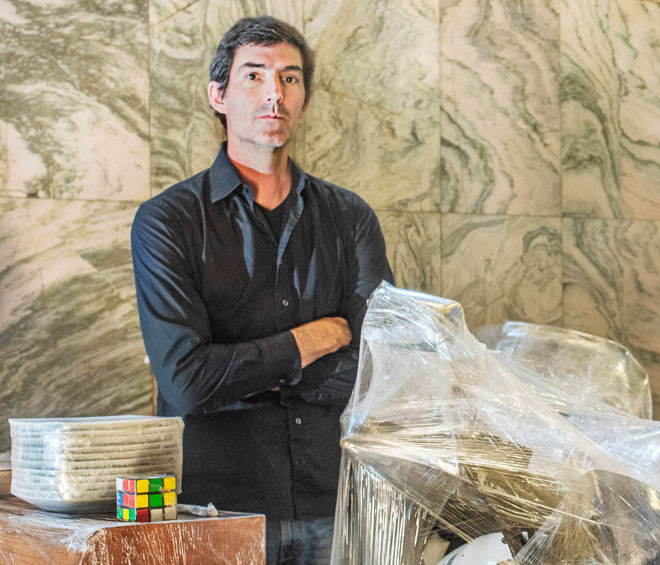
Pepe López. Photo: Thierry Bal.
by ANGERIA RIGAMONTI di CUTÒ
The mesmerising exhibition of personal items wrapped in clingfilm by Pepe López (b1966, Caracas) is the debut project of Ruya Maps, a non-profit organisation curating visual artworks originating in areas of political strife. The 18-metre long installation, on show, at the end of last month, in the jewel-like Fitzrovia Chapel in London, tells a personal, national, but also universal, story of exile in which López presents about 200 swathed objects, mostly from his family home in Venezuela, his lost domain.
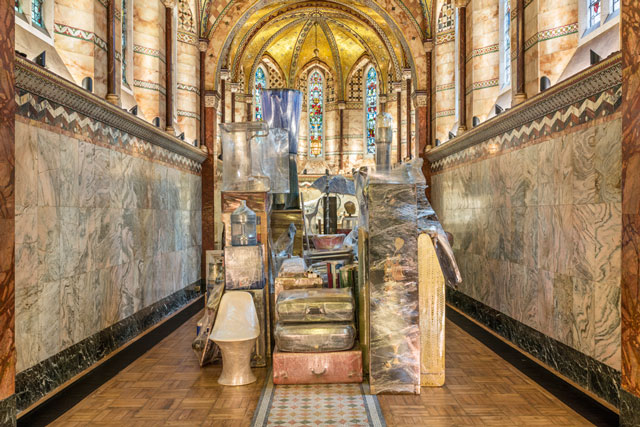
Pepe López: Crisálida, installation view. Photo: Thierry Bal. Courtesy the artist and RUYA MAPS.
López’s arrangement of artistic and domestic artefacts produces charismatically surreal combinations, but Crisálida (2017) also functions as a map of movements between the old and new worlds of Europe and America, the many suitcases a leitmotif evoking the fraught yet hopeful process of packing up a life that expatriation entails. The installation also calls to mind the often-spectral quality of shrouded art objects, whether Giuseppe Sanmartino’s Veiled Christ (1753) or Iain Baxter&’s 1966 Bagged Place, and its later rendition, Rebecca’s Bagged Place, in which the artist shrink-wrapped the contents of an apartment whose owner had recently died. López seeks to transmute the sense of loss evoked by mummified objects by placing them in a public art installation, and in doing so, saying goodbye to them.
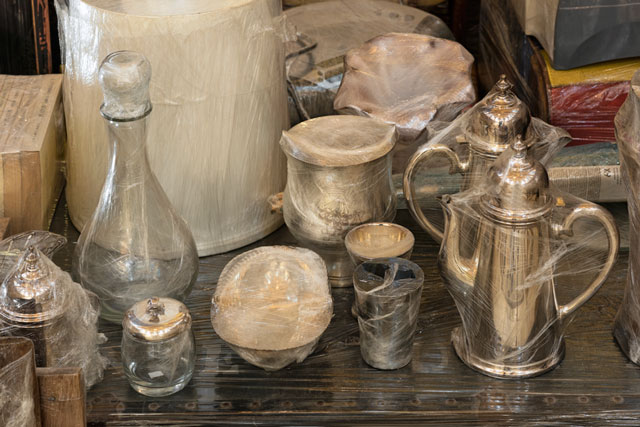
Pepe López: Crisálida, installation view. Photo: Thierry Bal. Courtesy the artist and RUYA MAPS.
Angeria Rigamonti di Cutò: By way of an introduction, can you tell us about your early artistic or cultural reference points? I understand you were influenced by Armando Reverón, creator of fantastically eccentric dolls, and uncanny painted seascapes. In stark contrast, presumably the strong presence of kineticism and formalist abstraction in Venezuela and Latin America was also a force to be reckoned with?
Pepe López: I was born in the 60s in Venezuela. Caracas was a vibrant Latin-American cultural hub with many museums, contemporary art galleries and prestigious cultural institutions. Art was everywhere in the city and Armando Reverón was the local cultural reference for Venezuelan artists; he was the great painter who understood the light in the tropics. Reverón lived in the mountains by the sea and was this kind of crazy man who created his own fantastic world. He was perceived as a local Venezuelan artist for Venezuelans, but he was already dead when I was born: he was an institution, a renowned artist before I even started my art adventure. Then there were geometric and kinetic forces: [Jesús Rafael] Soto, [Carlos] Cruz-Diez and co, who were the official cultural reference of the arts in democracy, an invasion of their work was happening all over the country. All major important public and private projects included a huge kinetic sculpture as part of their original plan. And then, later, politics and arts became the logical reaction of a group of artists concerned with social drift. I come from a country with huge economic and social inequalities. So, it was not just Reverón who influenced my artwork, but all Venezuelan artists and their relationships with our social reality.
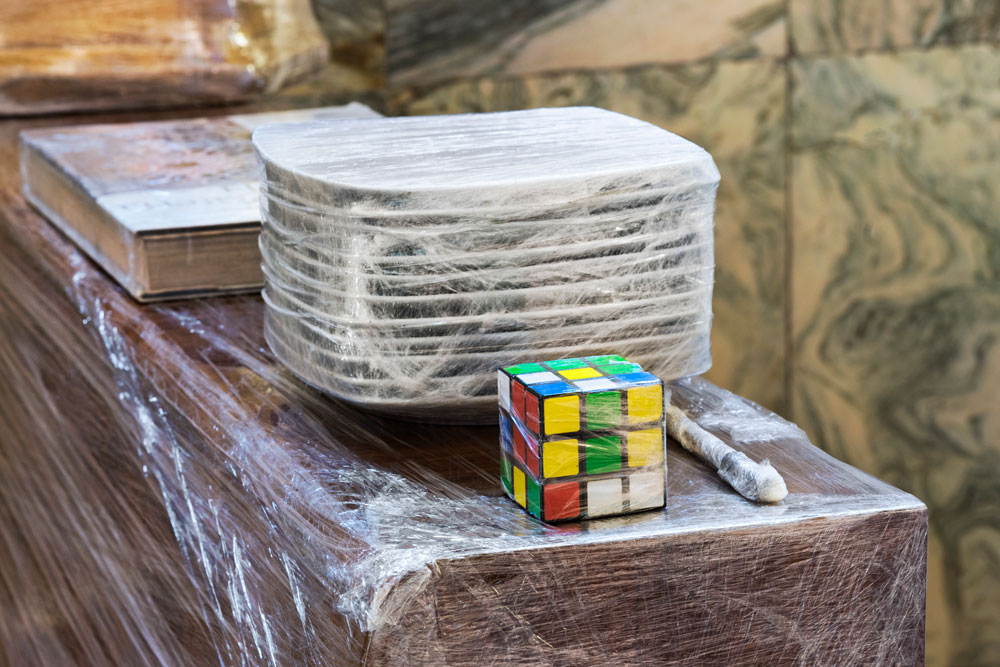
Pepe López: Crisálida, installation view. Photo: Thierry Bal. Courtesy the artist and RUYA MAPS.
ARC: The complete works of Plato in the installation are a reminder that you studied philosophy. How do you view the relationship between art and philosophy in your practice?
PL: There are many reasons I chose each of the objects included in Crisálida. We have many books at home and there are many books in the installation, but they are hidden in closed suitcases. And I had to make a choice. Which books should I display in Crisálida? My grandparents were Spanish republicans, they came to Venezuela running from the dictator, Franco. This Spanish edition of Plato’s complete works was translated by Juan David García Bacca, a prominent Spanish philosopher who also went into exile after criticising Franco and lived in Venezuela from 1946. After the Spanish civil war, Venezuela became a centre for Spanish refugees. We were a very rich country and people from all across Europe came to this beautiful land, running away from the civil war and from the second world war, looking for El Dorado. We had the most amazing will of inclusion and we wanted to build a country out of work and hope. But after 50 years this project failed. We are now living our own exile: Venezuela has become a country ruled by criminals, drug dealers and terrorists. Plato is no longer in Venezuela, he went into exile; nor is Simón Bolívar, nor María Lionza our local goddess. My country is no longer that dreamed of country full of future. But coming back to your question, I started a philosophy master’s programme once I graduated in civil engineering. I was tired of numbers and equations, I think I was looking to philosophy for some kind of freedom but, after two years of study, I was overwhelmed with this very rigid “kingdom” and I quit. Later on, I found that structural thinking is fundamental to my process. I can say now that there is always a balance between the different dimensions in my art practice and this structure is essential to me, to keep all the elements together.
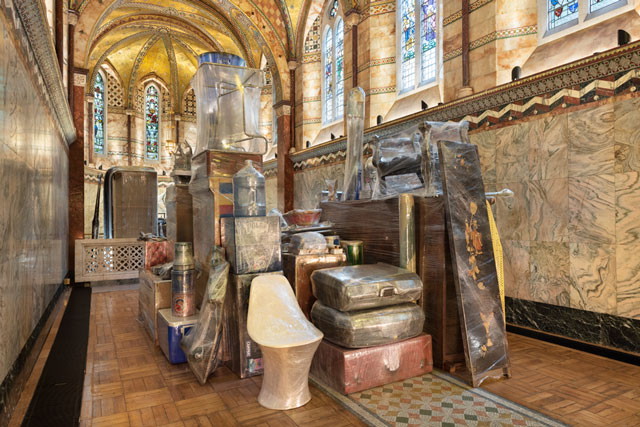
Pepe López: Crisálida, installation view. Photo: Thierry Bal. Courtesy the artist and RUYA MAPS.
ARC: What determined your choice of objects and their arrangement in Crisálida – were there other available objects you could have used?
PL: Just like Plato's complete works, every object choice is a determined decision in Crisálida. There are objects that belonged to my grandparents – they brought them from Spain in the 40s and now they have come all the way back to Europe. There are objects, such as the paella pan, which represent family Sunday luncheons at my parents’ home. Also included are my elder daughter’s bicycle and skateboard, my younger daughter’s gymnastics trophy, some of my wife’s shoes and some clothes and furniture that belonged to her family. There are also a couple of found objects and some others that were borrowed from friends who wanted to participate in the installation. All the objects are part of my life in Caracas and there are many memories attached to each of them. The arrangement of the objects is random, aleatory, but the proportions of the pile are determined by the gallery space. When I first showed Crisálida in Caracas, it was in a big white-walled room in a contemporary art gallery and the display was much more horizontal. Here, at Fitzrovia Chapel, I wanted to build it vertically, the chapel’s proportions determined the installation’s dimensions.
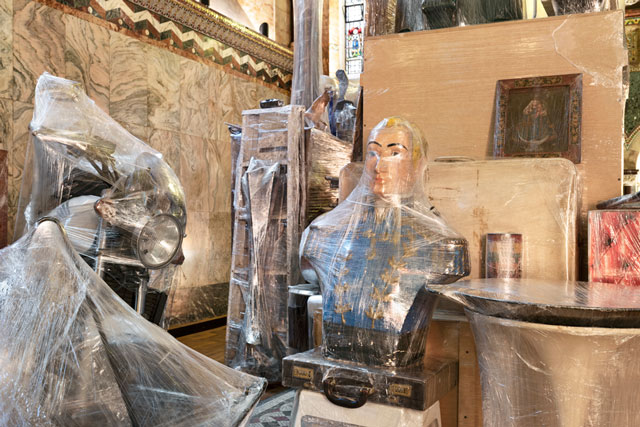
Pepe López: Crisálida, installation view. Photo: Thierry Bal. Courtesy the artist and RUYA MAPS.
ARC: In addition to the personal domestic items, your wrapped objects include works of art and design, your own and by, among others, Jésus Rafael Soto, Marcel Breuer, Philippe Starck, Eero Saarinen and Rodrigo Echeverri. This affects the more personal aspect of the installation, arguably suggesting a more art-related inflection. Or do you see these as personal objects like any other here – in the poignancy of exile, is a panettone equal to a Soto?
PL: These objects tell the story of my life up until now, and they all have a place in my memory and in my heart. Crisálida has an art inflection because it is the household contents of a family of artists. Also, Venezuela was a very modern country in the 50s, 60s and 70s and Saarinen, Breuer and [Charles and Ray] Eames, mid-century modern architects and designers, were and are still part of our tradition. But you are right, when it comes to exile, we keep all memories in the same place in the heart. A panettone represents for me Christmas with family. The Soto was my first artwork acquisition. When I was a teenager I saved money for years to buy this Soto silkscreen. Banal or substantial, I don’t discriminate. All these objects bring back memories of my life.
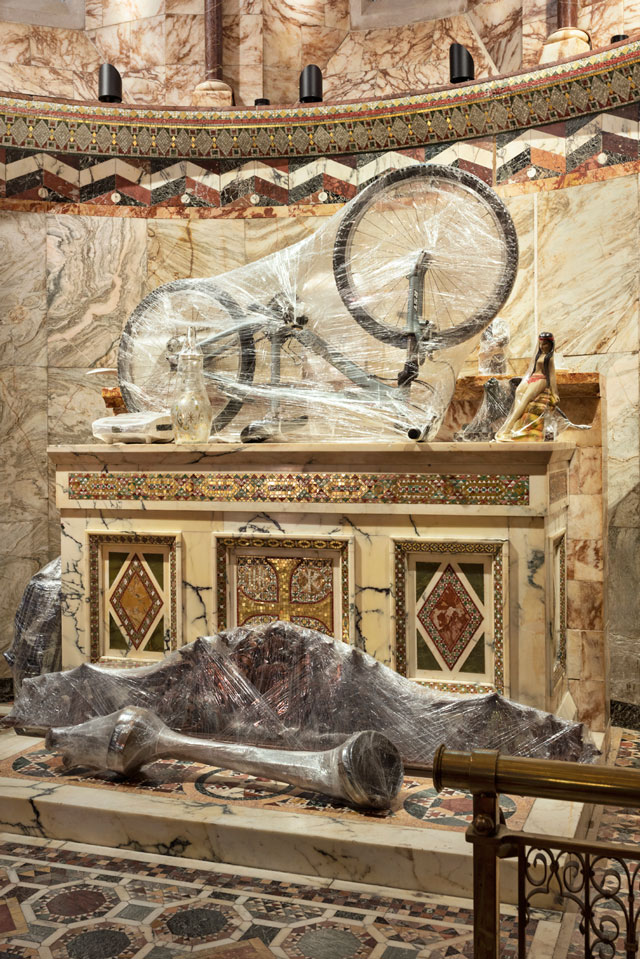
Pepe López: Crisálida, installation view. Photo: Thierry Bal. Courtesy the artist and RUYA MAPS.
ARC: There are also items here that suggest different kinds of travel, from emigration to tourism – mainly suitcases, but also an inflight Air France magazine, which suggests a more carefree type of journey. Was the prevalence of suitcases deliberate, given that they are quite emotionally charged objects?
PL: Packing your life in a suitcase. Crisálida is not about tourism. Suitcases are the first containers that you fill with personal items when you decide to migrate. My grandfather’s suitcase, the one he used in his exile is also here … and plenty of other suitcases, full of personal items. The Air France magazine refers to the country where I am now trying to settle down with my family. It happens that I was fortunate enough to travel by plane and in better conditions than most of my fellow citizens. But what I really want to share with Crisálida is loss and transformation. Even for the great majority of Venezuelans who could not migrate, and still live in my country, the strongest feeling of this social drift is the loss. And the urgent reaction to this collective failure is transformation.
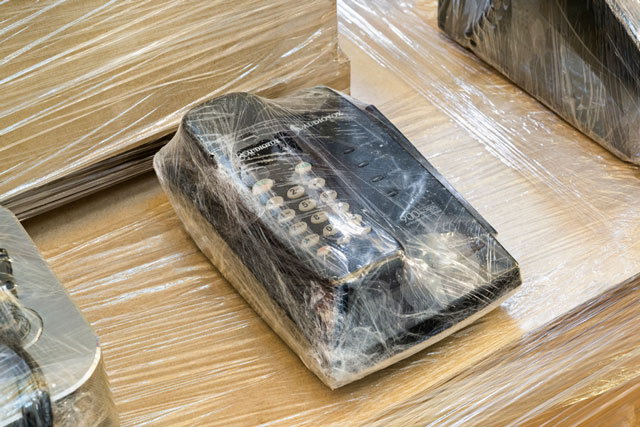
Pepe López: Crisálida, installation view. Photo: Thierry Bal. Courtesy the artist and RUYA MAPS.
ARC: There’s a natural dialogue between the shimmer of the clingfilm wrapping your objects and the chapel’s bejewelled surfaces. How does the context here inform this version of the exhibition, previously shown in a white-cube setting in Caracas: does it lend a more sacred, or perhaps distancing, quality to the installation?
PL: The word chrysalis is derived from the Greek word chrysos, meaning gold. Some monarch butterfly pupae are completely covered in a golden draping. My Crisálida, exhibited at Fitzrovia Chapel, has the appearance of an optical illusion, it reflects its surroundings like a mirror. It is very impressive how the clingfilm reflects the golden tiles of the chapel: this relation gives a phantasmagorical atmosphere to the installation. In the white-cube gallery the installation looked brighter, more colourful. Here, the atmosphere is the protagonist more than the individual objects. In Caracas, I was surrounded by affection, the installation was perceived with a sense of geographical and emotional belonging. Here in London, all my things are out of context but nevertheless a trashcan becomes sacred. Exhibiting Crisálida here feels like the process of its transformation has been blessed.
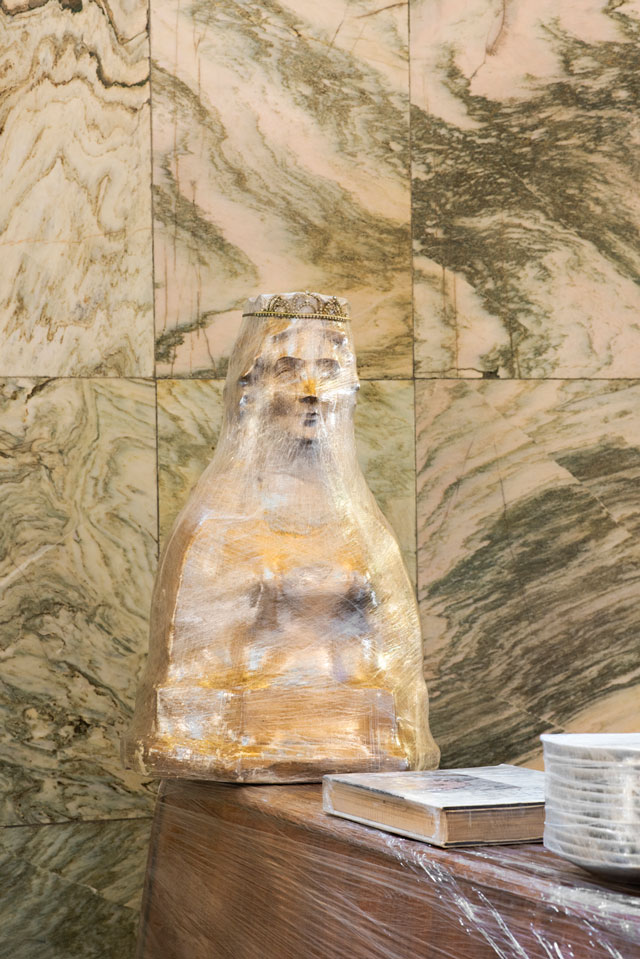
Pepe López: Crisálida, installation view. Photo: Thierry Bal. Courtesy the artist and RUYA MAPS.
ARC: The exhibition catalogue presents the list of works as an “inventory”. Despite the reference to a clinical shipping ledger, the list is a poignant document in the way it meticulously, at times poetically, describes the objects’ original location, installation, or function – for example, Paloma’s bedroom, or the cart bought for market shopping before a big dinner with friends. Was it hard to write down those details?
PL: I feel that wrapping and exhibiting all my stuff at Espacio Monitor in Caracas, and then describing the objects for the catalogue, and then bringing Crisálida and exhibiting it here in London, has made me feel that, even if I own these objects, they no longer belong to us, they no longer belong to me. This is a very intimate work. I was home alone, wrapping individually each object that is part of Crisálida. It was therapy. The whole process up to now has been very emotional. To connect each object with a memory in time and space has been a farewell. It was painful to write those details, but in a different way it was also a happy moment to remember parts of my family life.
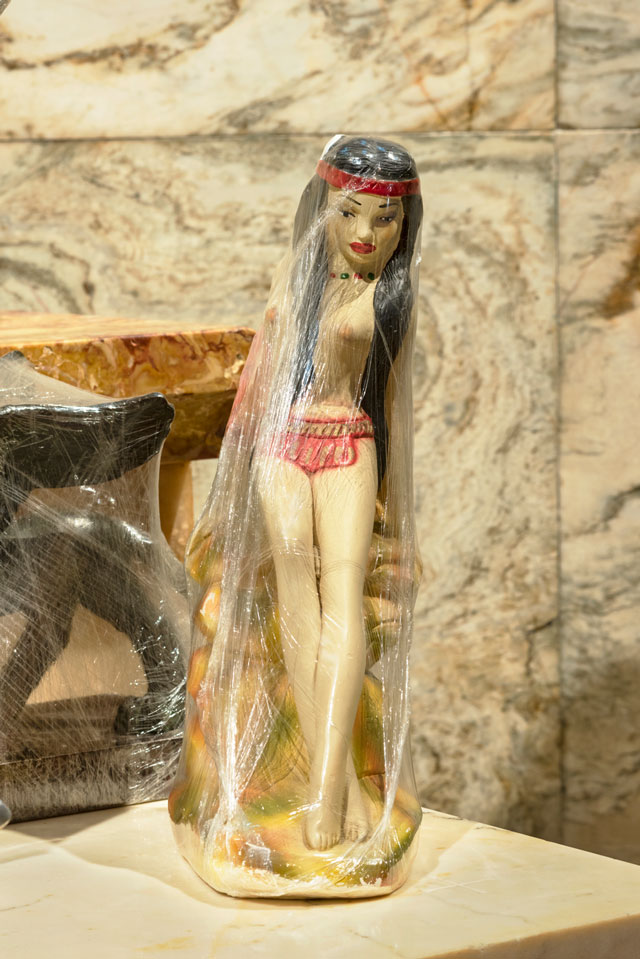
Pepe López: Crisálida, installation view. Photo: Thierry Bal. Courtesy the artist and RUYA MAPS.
ARC: The inventory shifts from the micro to the macro: in addition to your family, we encounter references to friends, neighbours, as well as sociocultural expressions of Venezuela, relating to food, musical instruments or Santería beliefs. Was it important to present a wider story of Venezuela, as well as a personal self-portrait of exile – your other work is much more centred on collective contexts?
PL: This inventory is personal, even if I included several objects that belong to friends and family, they could have been my own objects, all of them. There are drums in Crisálida because they are part of my art collective projects, but I know that in every house of my country there is a musical instrument, a drum, a cuatro or a piano. We are a very musical and happy people. Crisálida is the contents of a household, of a family in any Venezuelan city, in any Venezuelan home. It doesn't matter if you are rich or poor, if you are an artist, a taxi driver or a waiter, we are facing this drift all together, as a collective. This social and political situation is touching society transversally. It is personal becoming collective. My story is the story of my family, of my neighbours, of my people. My people’s stories are my own story.
ARC: In his resistance memoir If This Is a Man, Primo Levi wrote: “The most immediate fruit of exile, of uprooting … is the prevalence of the unreal over the real.” Does the staging of your personal belongings from Venezuela, in a public setting thousands of miles away from “home”, enhance this sense of unreality that Levi refers to?
PL: Once you take time for mourning, for detaching yourself from your possessions, you start feeling less grief and sorrow. It is a strategy of transformation. These objects from my day-to-day life are now taking a relative hierarchy in my memory. I like Primo Levi’s idea of unreality versus reality as it refers to the prevalence of dreams and illusions over a harsh reality. But Crisálida at Fitzrovia Chapel is a very strange dreamlike situation, an irrational combination. Having all my things from Caracas piled inside a chapel in London is more of a surrealist art proposition. I strongly embraced the choice of venue for the show, as it gave the installation a whole new meaning – the process of the transformation of Crisálida had already begun, and my chrysalis was already taking a new step.
• Crisálida was exhibited last month in Fitzrovia Chapel in London.
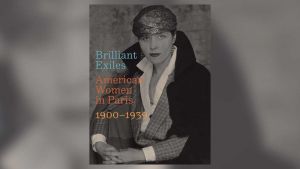 Brilliant Exiles: American Women in Paris 1900-1939 – book review
Brilliant Exiles: American Women in Paris 1900-1939 – book review
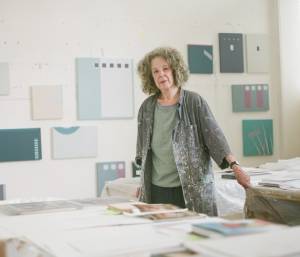 Tess Jaray – interview: ‘Ways of being an artist have massively expanded’
Tess Jaray – interview: ‘Ways of being an artist have massively expanded’
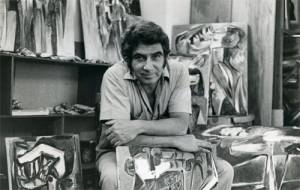 ‘Oswaldo Vigas said he found the root of his work in ancient culture’
‘Oswaldo Vigas said he found the root of his work in ancient culture’
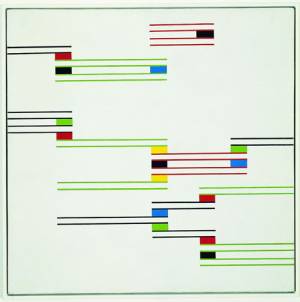 Radical Geometry: Modern Art of South America from the Patricia Phelps de Cisneros Collection
Radical Geometry: Modern Art of South America from the Patricia Phelps de Cisneros Collection